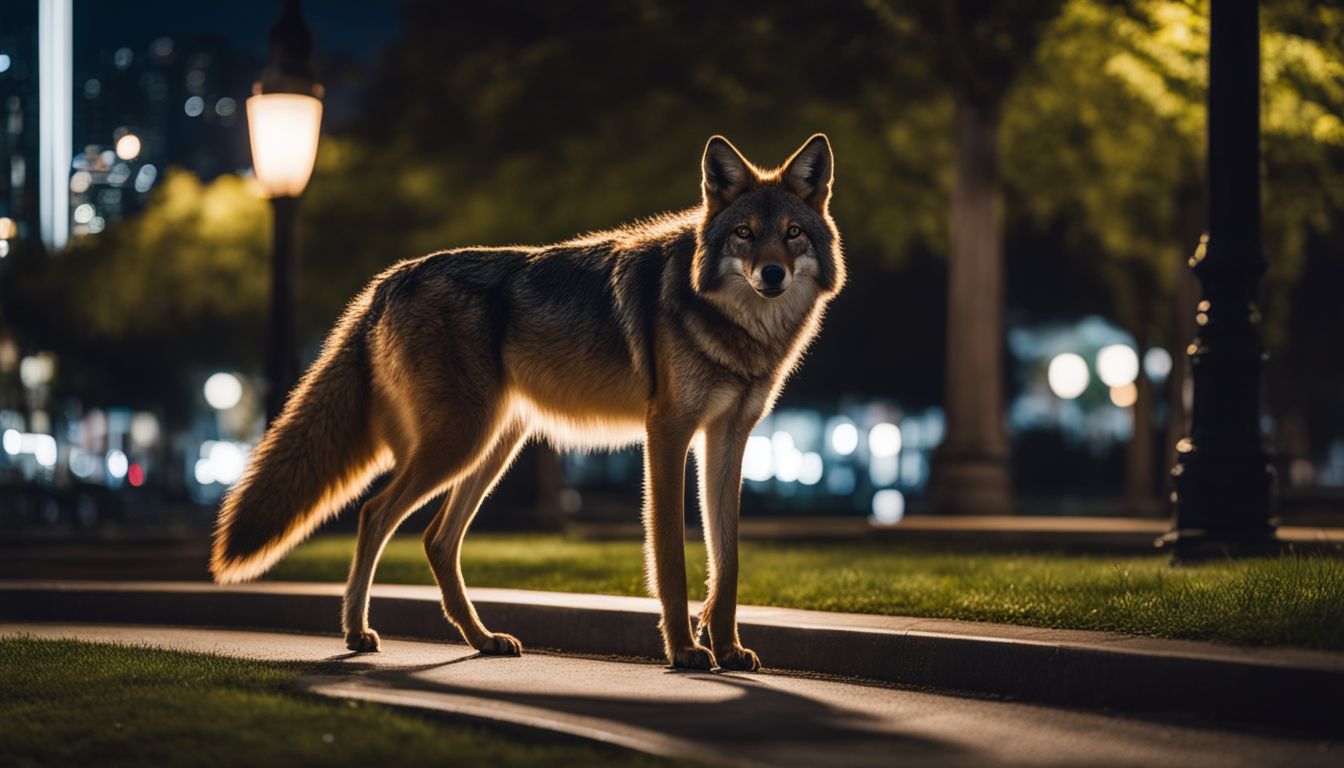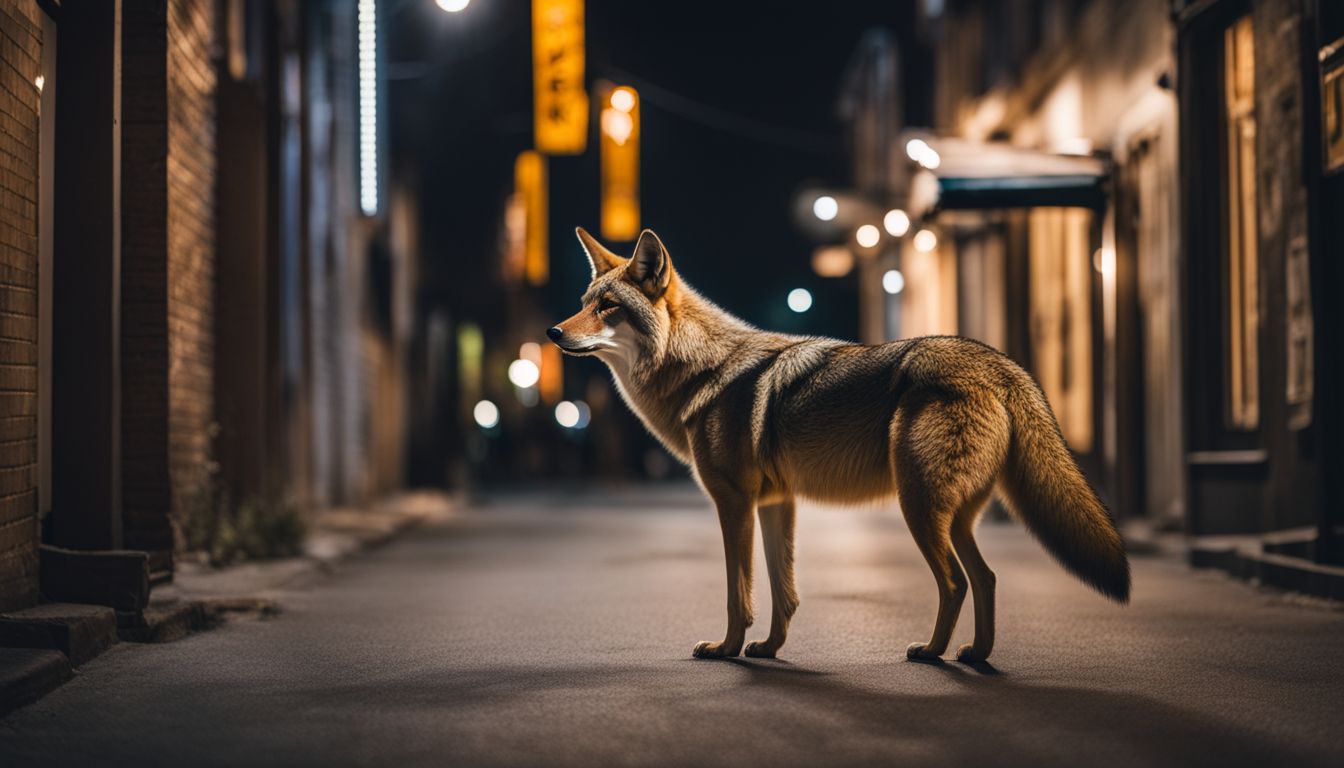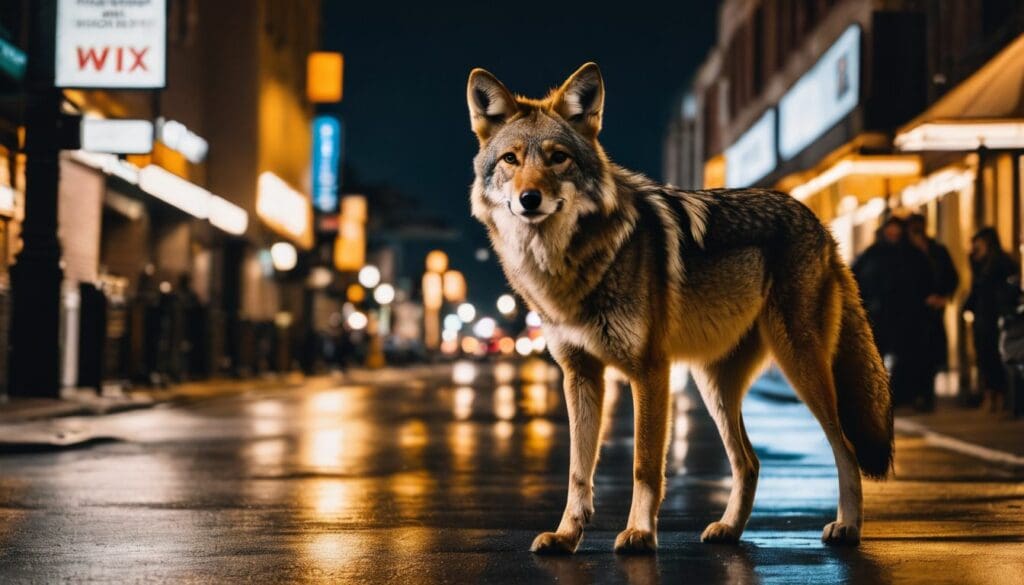Encountering a coyote ambling through your neighbourhood can be quite disconcerting. Trust us, we understand the feeling all too well, having experienced it firsthand. Intriguingly enough, it appears that urban coyotes are evolving their behaviours to flourish amidst our cityscapes.
Our research offers an insightful exploration into the practical measures by which we may coexist peacefully with these remarkably adaptable animals. Learn how we can collectively embrace this challenge with understanding and cooperation.
Key Takeaways
- Urban coyotes are adapting to live within city environments, often seen navigating parks and residential areas in search of food.
- Human – coyote conflicts often arise from coyotes scavenging for food, feeling threatened, or experiencing habitat encroachment due to urban expansion.
- Public education on coyote behaviour and safe practices like securing bins, not feeding wildlife, and keeping pets secure can help reduce negative encounters with these adaptable animals.
- Implementing deterrents such as motion – sensitive lighting and proper fencing can discourage coyotes from visiting residential properties.
- Participating in community coexistence programs advocates for a balanced ecosystem where both humans and urban wildlife such as coyotes can thrive.
Background on Urban Coyotes

As cities expand, coyotes are becoming a common sight in our urban landscapes, displaying remarkable adaptability to the hustle and bustle that comes with city life. They navigate this new terrain with surprising ease, often unseen by the very residents with whom they share their territory.
Coyote behaviour in urban environments
In urban environments, coyotes exhibit both adaptability and caution. They often navigate the city’s patchwork of parks and green spaces, staying out of sight during the day. These clever canines have learned to patrol streets and alleys at night in search of food.
Coyotes may feed on rodents or feral cats, which helps control these populations – an unexpected benefit to urban ecology.
We must understand that coyotes take advantage of resources humans unintentionally offer, such as unsecured rubbish or pet food left outside. Their behaviour reflects their keen survival instincts; they’re opportunistic hunters that will seize any chance for a meal.
Despite their resourcefulness, they generally avoid humans and pose little threat when not provoked or habituated by human actions like feeding wildlife.
Coyote adaptation to urban territories
As urban wildlife, coyotes show remarkable adaptability to city life. They learn quickly to navigate the maze of streets and alleys in search of food. These cunning animals have fine-tuned their hunting skills, often going after smaller prey that thrives in urban areas, such as rodents and rabbits.
With habitat loss mounting, they are increasingly calling our backyards and parks home.
We see them adjust their behaviour for survival amidst the hustle and bustle. Coyotes become nocturnal creatures in cities to avoid human contact, a smart move that keeps them safe and less noticeable.
Their diets change too; they scavenge more from our leftovers than they would in wilder territories. Despite risks posed by cars, pest management measures and aggressive dogs, these adaptable canines flourish near humans by staying elusive yet opportunistic.
Human-Coyote Conflicts in Urban Areas

In our cities, encounters between humans and coyotes are on the rise, leading to a complex web of challenges that we must navigate with care. These incidents often stem from both parties’ struggle to share space and resources in the ever-expanding urban landscape.
Causes of conflicts
We often find that conflicts between humans and coyotes stem from a lack of natural prey in urban areas. Coyotes then turn to hunting pets or scavenging through rubbish, which brings them into our neighbourhoods.
Competition for space also heightens tensions; as cities expand, we encroach on their territory, forcing these adaptable creatures to adjust to living amongst us.
Misunderstandings about coyote behaviour contribute significantly to conflicts. Some people unknowingly invite trouble by feeding wildlife, not realising this teaches coyotes to associate humans with food – a dangerous link.
On social media, sensational stories about human-wildlife conflicts can spread fear and misinformation instead of promoting coexistence. By understanding what drives these animals into conflict with us – whether it’s the hunt for food or simply survival in an ever-shrinking habitat – we stand a better chance at finding harmonious solutions.
Examples of human-coyote conflicts
As urban wildlife management becomes a growing concern, we frequently hear about incidents where coyotes clash with human residents. These conflicts often arise as these adaptable animals navigate the challenges of living alongside us in our cities.
- Pets face risks from coyotes who may view them as prey or threats. Small dogs and cats are particularly vulnerable during dusk and dawn when coyotes are most active.
- Coyotes that learn to associate humans with food can become bold, scavenging in backyards, playgrounds, or even approaching people directly to beg for handouts. This behaviour can lead to aggressive encounters.
- Damage to property presents another form of conflict. Coyotes looking for food could tip over bins, damage gardens or make dens on private grounds.
- Public safety concerns escalate when coyotes lose their fear of humans. In rare cases, they might threaten human safety by acting defensively if they perceive a threat to themselves or their young ones.
- Reports on pets and local wildlife disappearing have increased in some communities signalling that the presence of coyotes sometimes contributes to such incidences.
Challenges of Coexisting with Urban Coyotes
In our cities, we’re increasingly crossing paths with urban coyotes, raising unique challenges that come with sharing our spaces. It’s a complex blend of ensuring public safety and fostering harmony between human interests and the well-being of these adaptable canines.
Public safety concerns
Living alongside urban coyotes brings public safety to the forefront of our concerns. We hear alarming stories about encounters that raise fear and anxiety within communities. Coyotes, attracted by food or sometimes just exploring, occasionally venture too close for comfort to children’s play areas and bustling streets.
Their presence can disrupt daily routines as residents become wary of the potential risks involved with a wild predator nearby.
We take these worries seriously and understand they impact not only our peace of mind but also our community’s wellbeing. Educating ourselves on coyote behavior is crucial—we must strive for awareness without panic.
Vigilance helps us spot any changes in local wildlife patterns, empowering us to act swiftly in safeguarding both people and animals from harm’s way.
Impact on pets and other wildlife
Moving beyond our own safety, we must also consider how urban coyotes affect pets and local wildlife. Coyotes can see domesticated dogs as rivals or prey, leading to stressful encounters or attacks.
Cats are particularly vulnerable at night when coyotes are most active; keeping them indoors can prevent tragedy.
Our feathered friends and smaller mammals aren’t spared either. Coyote presence disrupts the balance of urban ecosystems by preying on birds, squirrels, and rabbits. To support biodiversity in our cities, it’s crucial that we adopt measures such as securing trash and avoiding feeding wildlife to reduce these pressures on other species living among us.
Damage to property
We need to talk about the real impact urban coyotes have on properties. Their search for food often leads them into our backyards, where they might dig up gardens or tip over bins.
These actions can result in costly repairs and an increased amount of waste to manage. It’s not just physical damage, though; the presence of coyotes sometimes lowers property values as potential buyers might be wary of wildlife encounters.
Managing these situations calls for thoughtful strategies that ensure safety while respecting the ecology of these animals. This includes securing trash cans, putting up fences that deter entry, and educating communities on how to handle any encounters with coyotes effectively.
Next, let’s explore assessing coyote behaviour in urban environments to understand their patterns better and reduce potential damage to our homes.
Assessing Coyote Behaviour in Urban Environments
Understanding the way coyotes behave in our cities is essential for harmonious coexistence. We delve into how these clever canines navigate urban landscapes, revealing patterns that might just surprise you.
Seasonal behaviour influencing coyote sightings
As the seasons change, so do coyote behaviours. In spring and summer, they’re often more visible as they search for food to feed their young pups. We see them roaming during daylight hours, which can lead to more encounters with humans.
Autumn brings a shift; coyotes become more nocturnal, trying to avoid direct contact while still hunting for enough sustenance to prepare for winter.
Coyote activity peaks as cooler weather sets in. They need more calories to maintain body heat, so they may venture closer to human habitats where food is easier to find. This could be when we notice them most around our neighbourhoods or even rummaging through bins left out overnight.
Being aware of these patterns helps us anticipate their presence and act responsibly to minimise conflicts.
Coyote family characteristics
Shifting our focus from lone sightings, let’s consider the social structure of these adaptable creatures. Coyote families are tight-knit units with a surprising level of organisation.
Typically led by an alpha pair, they exhibit deep bonds and cooperative behaviour that ensure their survival in challenging environments. These alphas are the dominant male and female that guide the group, often consisting of related individuals like offspring from previous years.
Their communication is intricate, involving vocalisations such as howls and yips to maintain territory and unity within the family. This complex social dynamic plays a crucial role in hunting strategies and raising pups, showcasing their ability to thrive not just as individuals but as members of a sophisticated unit.
Pups learn quickly from older coyotes – mastering skills like foraging and understanding urban landscapes in ways that align quite closely with human-related activities.
Indicators of coyote presence near residential areas
Coyotes are becoming a common sight in our cities. We often notice signs of their presence before we see the animals themselves.
- Tracks and trails: Coyote paw prints are distinguishable by their oval shape and claw marks. In urban green spaces, look for paths worn into grassy areas or mud where these adaptable creatures tread regularly.
- Scat sightings: Like most canids, coyotes use their droppings to mark territory. You might spot their scat on sidewalks or near food sources; it typically contains fur or seeds from fruits.
- Sounds at night: Their howls and yips pierce the stillness of suburban nights. These vocalisations serve as communication among coyote packs, especially during mating season.
- Overturned bins: Resourceful scavengers, coyotes will rummage through rubbish for scraps. Finding bin lids open and refuse scattered is a tell-tale sign of their search for an easy meal.
- Missing pets: Sadly, an increase in missing cats or small dogs may indicate predatory behaviour, particularly if such disappearances become frequent in your area.
- Sightings at dusk or dawn: Coyotes prefer moving around during twilight hours when human activity is lower. Spotting them at these times can suggest they’re living nearby.
Strategies for Fostering Coexistence
We’ll explore practical ways to harmoniously share our urban spaces with these adaptable canines, inviting you to join the conversation on nurturing a safer cohabitation.
Coexistence tips for urban residents
Living among coyotes in our cities requires understanding and adaptability from us all. Here are several practical tips to ensure a harmonious relationship with these urban dwellers.
- Keep food sources inaccessible: Secure rubbish bins with locking lids and don’t leave pet food outside. This discourages coyotes from foraging near human habitats.
- Protect pets: Never let cats or small dogs roam freely, especially at night when coyotes are most active. In your garden, supervise them closely.
- Install motion-sensitive lighting: Bright lights can deter coyotes from entering your property. It adds an extra layer of security to your home’s surroundings.
- Build fences properly: A fence should be at least 6 feet tall and extend underground to prevent coyotes from digging under it.
- Educate the community: Share knowledge about coyote ecology and behaviour. Informing others helps everyone understand the importance of living peacefully with wildlife.
- Haze or scare them away safely: Use loud noises or spray water to frighten off a coyote without harming it. This reaffirms their natural fear of humans.
- Report sightings responsibly: Communicate any encounters with local wildlife services so they can monitor coyote activity and take action if needed.
- Modify landscaping: Reduce shrubbery where coyotes could hide near playgrounds or walkways, maintaining clear visibility in communal outdoor areas.
- Encourage responsible rodent control: Avoid using poisons that can indirectly harm coyotes through bioaccumulation. Seek ecologically friendly pest control methods instead.
- Participate in coexistence programs: Support initiatives by conservation groups that aim to foster harmony between urban residents and the local wildlife population.
Measures to prevent frequent coyote visits
We must take proactive steps to deter coyotes from frequenting our neighbourhoods. Implementing the following strategies will help reduce coyote encounters and promote a safer coexistence.
- Secure food sources by keeping garbage bins tightly closed. Coyotes often forage in trash, so making sure bins are inaccessible can discourage their visits.
- Install motion – sensitive lighting around your property. The sudden brightness often startles wildlife, including coyotes, which may prevent them from entering your yard.
- Build fences that are at least six feet tall with a 45 – degree outward angle at the top. This design makes it difficult for coyotes to climb over and enter your garden or compound.
- Remove any potential shelter options for coyotes like thick brush or wood piles. Keeping gardens clear of these hiding spots reduces the chances of a coyote setting up residence nearby.
- Keep pets indoors during dusk and dawn when coyotes are most active. Small pets, in particular, should not be left outside unsupervised as they can be seen as prey.
- Use noise – making devices when you encounter a coyote. Loud noises can scare them away and make them think twice before returning to the area.
What to do if a coyote is near
Encountering a coyote in our urban environment can be an unexpected event. Here’s what we need to do if one of these wild canines is nearby:
- Stay calm and maintain a composed stance. It’s crucial not to run or turn our backs, as this could trigger a chase.
- Make ourselves appear larger by raising our arms or opening our jackets. This act of intimidation may persuade the coyote to back off.
- Back away slowly while keeping steady eye contact with the animal. Sudden movements might startle it and provoke an undesired reaction.
- Shout loudly or use noisemakers if the coyote seems too close for comfort. Sound can act as a deterrent, making it clear that it is not welcome.
- Keep dogs on a short leash and pick up small pets immediately. Ensuring their safety avoids potential conflicts involving our furry companions.
- Throw objects near the coyote to scare it without aiming directly at it, as the goal is to frighten, not injure.
- Report sightings and any aggressive encounters to local wildlife officials. They need this information to manage coexistence effectively.
Case Studies
7. Case Studies: We delve into the success story of San Francisco’s harmonisation efforts and scrutinise how urban coyote behaviour affects peaceful cohabitation. These real-world examples bring to light the practicalities and nuances involved in urban wildlife management.
Coexistence efforts in San Francisco
In San Francisco, we’re pioneering new ways to live harmoniously with coyotes. Our city’s initiatives focus on educating the public about these adaptable canines. We teach residents how to safely share spaces, discourage feeding wildlife, and secure trash bins to prevent attracting these curious creatures into residential areas.
Our approach includes the use of humane deterrents and promoting pet safety through leashing laws in parks where coyotes roam. Working closely with animal ecology experts, we strive for a balanced ecosystem where humans and urban wildlife can thrive together.
Moving forward, understanding coyote behaviour plays a key role in enhancing our coexistence strategies.
Assessment of coyote behaviour and its impact on coexistence
Understanding coyote behaviour is crucial for our coexistence with these adaptable animals. We track seasonal patterns to predict when they’re more likely to roam urban areas, especially during mating and pup-rearing seasons.
By studying how coyotes form family units, we gain insight into their interactions within the urban landscape. This knowledge helps us create strategies that encourage harmony between humans and wildlife.
Recognising indicators of a nearby coyote presence, such as tracks or droppings in residential zones, alerts us to potential overlap between human and coyote activities. With this information, we can educate communities on living safely alongside these creatures without unnecessary conflicts.
Our approach combines ecological understanding with practical measures aimed at reducing negative encounters while respecting the natural behaviours of urban coyotes.
The Future of Coexisting with Urban Coyotes
As urban landscapes continue to expand, the need for innovative solutions to foster harmony between humans and coyotes becomes more pressing. We’ll delve into proactive measures and educational strategies that can reshape our shared future with these resilient urban dwellers.
How coyotes and humans can learn to coexist in cities
We can encourage coexistence between coyotes and humans in cities by understanding the creatures’ habits and making small changes to our environment. Securing bins, fencing off gardens, and keeping pets indoors at night reduce temptations that might lure coyotes into urban areas.
Investing time in public education about not feeding wildlife helps maintain a healthy distance.
Our actions can also extend to supporting city planning initiatives that create greenspaces where coyotes can roam safely. These spaces provide natural habitats away from residential zones, helping to minimise encounters with humans.
We need to advocate for policies that prevent habitat loss, ensuring there’s room for all urban dwellers – be they human or coyote. Through these efforts, we make our cities safer and more welcoming for everyone.
Challenges and solutions for the future
Living alongside coyotes in our cities presents us with complex challenges. As these adaptable creatures evolve, they become more adept at navigating our streets and parks, leading to increased sightings and potential conflicts.
Public safety is a prime concern; finding ways to maintain a safe distance between humans and coyotes is crucial. Pets are also at risk, often becoming targets for opportunistic coyotes.
Moreover, the damage caused by these animals can impact local ecosystems as well as personal property.
Solutions lie in education and proactive measures. By understanding the behaviour of urban coyotes — their family dynamics, seasonal habits, and signs of nearby activity — we empower ourselves to act responsibly.
This knowledge enables us to implement effective strategies that reduce negative interactions without harming wildlife populations or disrupting ecological balance. Fostering coexistence involves adapting our own behaviours too: securing trash, supervising pets outdoors, and refraining from feeding wild animals are all steps we must take consistently.
In doing so, we support not just the survival of the friendliest but also ensure a respectful sharing of habitat within our ever-expanding urban landscapes.
Conclusion
We must embrace the reality that coyotes are here to stay in our urban landscapes. Adapting our behaviour and educating ourselves on their habits is key. By implementing proactive measures, we foster a safer cohabitation.
It’s crucial for us to work together with wildlife experts to ensure a balanced ecosystem. Embracing this challenge invites harmony between humans and nature in our shared environment.
FAQs
1. What challenges do urban areas face with coyotes?
Urban areas face challenges as coyotes adapt to city living, often leading to conflicts reported by residents and the need for ecological engineering solutions.
2. How has climate change affected urban wildlife like coyotes?
Climate change alters habitats and food availability, which pushes coyotes and other wildlife such as foxes into cities, potentially increasing human-wildlife conflict.
3. Can researchers help reduce conflicts with coyotes in cities?
Yes, researchers use geospatial analyses and study ecological factors to understand behaviors and suggest ways to peacefully coexist with urban coyotes.
4. Why is public opinion on coexisting with coyotes important?
Public opinion shapes how communities manage encounters with coyotes, including policies like banning rodenticides that could harm them unintentionally.
5. Do changes in language affect our views on wildlife like coyotes?
Language used in media coverage can influence how we perceive animals; positive framing may encourage goodwill and prosocial attitudes towards cohabitation efforts.
6. Are there any humane methods for managing urban coyote populations?
Yes, instead of calling exterminators, experts recommend non-lethal methods such as habitat modification or community-based education programs for successful rehabilitation.





